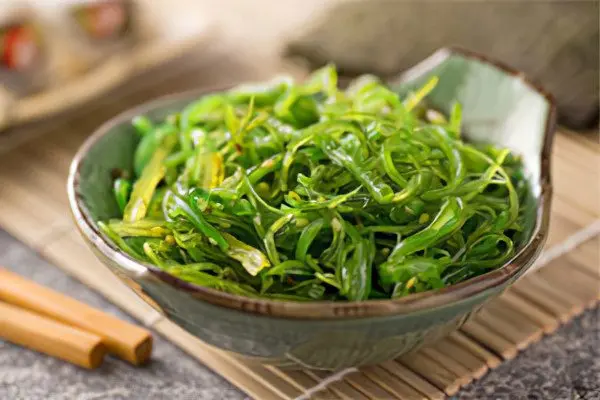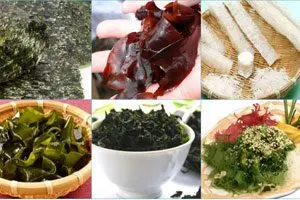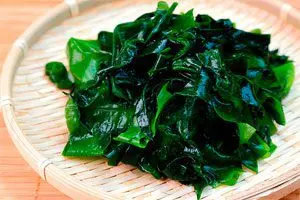There are over 30000 types of seaweed. Some of them people began to eat many centuries ago. Other algae are used to extract agar, carrageenan, iodine. Algae people use in cosmetology and in the pharmaceutical industry
Description and composition of seaweed

Algae are unicellular organisms that can only exist in water. They grow in salty, fresh, alkaline and acidic waters. There are algae that can grow on land.
Algae have certain differences in chemical composition. However, they cannot be called essential. In most plants, the set of microelements is rather uniform. This applies to brown, red and green algae.
Algae contains minerals, acids, micro and macro elements, as well as other useful compounds, including:
Carbohydrates and proteins. There are no fats in algae.
Vitamin A, B vitamins, ascorbic acid, vitamin D3, M, PP.
Minerals, which are represented by fluorine, iodine, calcium, molybdenum, silicon, magnesium. The use of algae in food allows you to reduce the level of cholesterol in the blood, which is possible due to vanadium.
Carotenoid.
Chlorophyll.
Phenol.
pectin fibers.
Lignins.
Starch.
Polyunsaturated fatty acids.
Phytosterols.
Dextrins.
Polysaccharides.
Dietary fibers and fiber.
Ash.
Algae are low in calories. Nori has the highest energy value. It is 350 kcal per 100 g. The lowest calorie content in ulva is equivalent to 20 kcal.
Seaweed varieties

Scientists classify algae into groups depending on the pigmentation of plants, structural features of their cells, and a number of other features:
Green algae. These include sea lettuce (ulva) and sea grapes (umi budo).
Brown algae: fucus, kelp, wakame, aram, kombu. Wakame is the main ingredient in miso soup.
Red algae, which include dulse, laver and the famous nori. Sushi is prepared from the latter species of algae.
Blue-green algae. They are represented by chlorella and spirulina.
In more detail, you can dwell on the most common algae that a person uses more often than others:
Seaweed or kelp. This is one of the varieties of brown algae. Laminaria is a source of iodine. Moreover, it is contained in it in an organic form, which is practically not found in other products. In contact with water, the algae forms a gel, so eating it has a laxative effect. With the help of kelp, you can qualitatively clean the intestinal walls.
Fucus. This is another subspecies of brown algae. Fucus contains a lot of Omega-3 acids, so these algae are useful for people with heart and vascular diseases. They are actively included in the menu by patients with diabetes.
Spirulina. This plant belongs to the blue-green algae. It grows in the tropics and subtropics. Spirulina is actively grown in the laboratory. This prevents heavy metals and harmful substances from entering the plant cells. There are a lot of them in water bodies. Spirulina contains a lot of high-quality protein, its concentration in algae is 1,5 times higher than in soybeans. Based on this plant, medicines are made.
Arame. These algae are dark brown in color. They have a mild taste and are pleasantly crunchy. Algae are sold dried, cut into thin slices.
Nori. These plants are a source of phosphorus, vitamin A and protein. Also, nori can be found under the name laver or porphyry.
Kombu. These algae have a rich olive color, they are wide and flat. The taste of the plant is very rich. Kombu is rich in fucoxanthin. This substance is an excellent fat burner. Therefore, kombu can be found in the composition of dietary supplements for losing weight. The kombu is also called the kelp. These algae are a type of kelp.
Lithotamnia. This is a type of red algae. They contain many minerals and trace elements. Plants of this species are especially rich in magnesium and iron. Lithotamnia is used in medicine to combat anemia.
Khiziki. These algae are dark brown in color. They look like spaghetti. When the algae dry out, they turn black.
Ulva. These algae grow in the Black Sea. They are rich in proteins, iron salts and fiber. Many people include them in their diet. Ulva is also called sea lettuce.
Umi will be. These algae look like grapes. Plants taste salty. They contain antioxidants that are beneficial for the thyroid gland, and also prevent the division of atypical cells. Umi budo is often referred to as a sea grape.
Chuka algae
Algae are dark green or dark brown in color.
Plants of this species contain a significant amount of vitamins and minerals. They are also a source of calcium. It is 15 times more in them than in cow’s milk.
They are one of the ingredients in many salads, turning them into a real vitamin cocktail. The phytohormones present in them have a positive effect on the mucous membranes of the nasopharynx, intestines and genital organs. Grass is a natural absorbent, because it has the ability to absorb and remove harmful substances from the body.
For the same reason, it is not recommended to collect it in unverified places, because all parts of the plant also absorb toxic substances from the water, so they may not be suitable for consumption.
The benefits of seaweed

Since algae contain many different substances, they can be considered the most useful food.
They can have the following effects on the human body:
Reducing inflammation.
Enhance immunity.
Destruction of viruses. There is evidence that algae should be eaten by people with HIV.
Destruction of bacteria.
Seaweed Benefits:
Normalization of the thyroid gland. Algae are a source of iodine. This substance is essential for the thyroid gland. If the organ begins to work with disorders, then a person has such symptoms as: a set of overweight, malfunctions of the reproductive system, arrhythmia. When an iodine deficiency is observed in a child, he begins to lag behind in development. Seaweed contains tyrosine. This amino acid is needed by the body to produce hormones that are needed for the normal functioning of the thyroid gland.
Stabilization of blood pressure. Algae are a source of Omega-3 fatty acids. If you eat them regularly, it will positively affect the composition of the blood. The risk of developing cardiovascular pathologies decreases, the pressure returns to normal.
Saturation of the body with vitamins and minerals. Algae contain many useful substances, including iodine, calcium and iron. In some species of algae, vitamin B12 is present in significant amounts.
Antioxidant effect. Antioxidant protection is provided by vitamins A, E, C, carotenoids and flavonoids. They neutralize free radicals, reducing their pathogenic activity. Therefore, algae can be used to prevent diseases of the cardiovascular system and diabetes.
Normalization of bowel function. Algae contains sugars and fiber, which are fed by bacteria living in the intestines. Moreover, these substances are food for beneficial microflora. When fed, they actively multiply and inhibit the growth of harmful bacteria. Fucoxanthin is a pigment found in algae. When it enters the intestines, it binds to fats and brings them out. Alginate from algae protects the mucous membrane of the digestive tract from damage, prevents the development of gastritis and ulcers.
Increasing the body’s defenses. If you eat algae every day, then the intestines will definitely respond with gratitude, as beneficial bacteria will begin to multiply in it. Such changes have a positive effect on the state of immunity. Algae contains components that activate the production of white blood cells responsible for immunity.
Decreased body weight. Since algae contain few kilocalories, they do not allow fat to be deposited in the body. Weight loss occurs due to increased metabolic processes, which are activated by fucoxanthin.
Prevention of cardiological diseases. It is possible for the light to lower blood cholesterol levels. The pressure returns to normal, the likelihood of blood clots decreases.
Prevention of the development of type 2 diabetes mellitus. The decrease in blood glucose occurs due to alginate, fucoxanthin and other components that make up the algae.
Stabilization of hormonal levels in women. There is evidence that regular consumption of algae can normalize the level of estrogen in the blood. The higher its content in the body, the higher the likelihood of growth of malignant tumors of the breast and ovaries. Therefore, nori and kelp should be included in the menu of all women.
Detox effect. Algae contains fucoidan, which removes harmful substances and carcinogens from the body. Chlorella and spirulina are rich in chlorophyll, so their consumption in food allows you to cleanse the blood of toxins, as well as lower cholesterol levels. Alginic acid salts from algae help protect the body from the effects of radiation.
Saturation of the body with protein. Algae are an excellent source of protein. Therefore, they are often included in their diet by people involved in sports. They allow you to quickly build muscle mass and restore strength after training.
Rejuvenation of the body. The use of algae in food has a positive effect on the condition of hair, nails and skin. In cosmetology, algae are used in their pure form, as well as extracts and extracts based on them.
Video: Why are seaweed useful? — Dr. Michael Greger:









